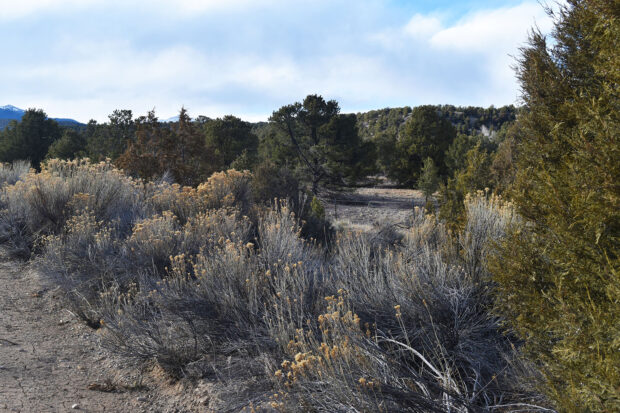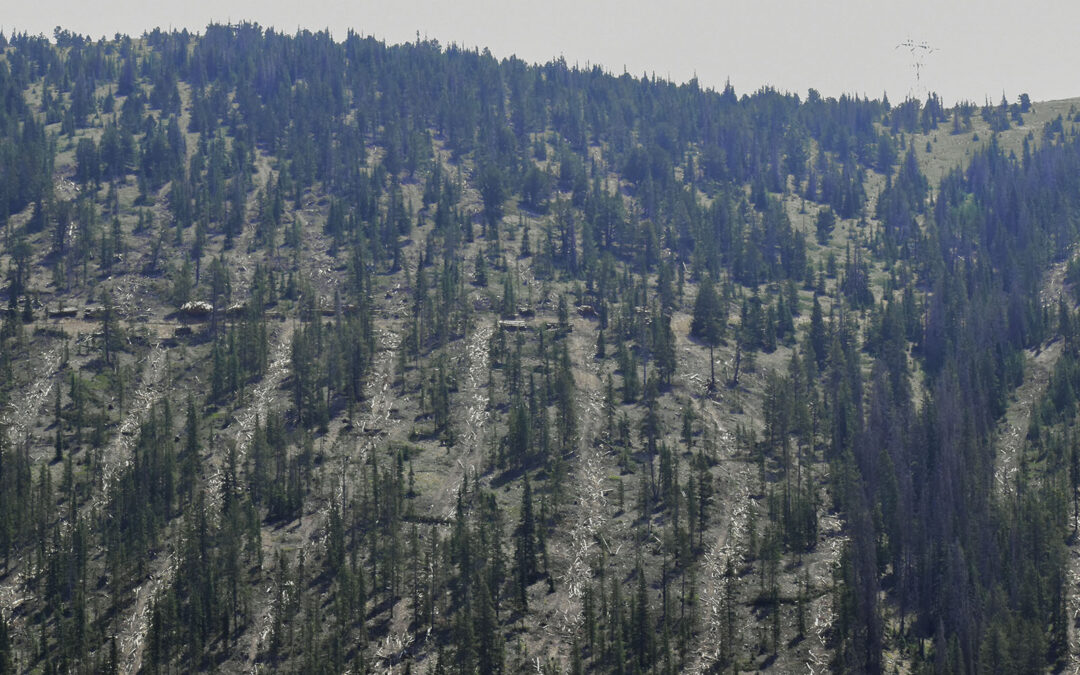How a Community Planning Project Spawned a Forest Health Collaborative
Christopher Ketcham’s guest column in the Fall 2022 edition of Forest News struck a chord with me. Ketcham’s column, excerpted from his book, This Land, reveals how forest health collaboratives became, in the words of Barry Rosenberg, “a significant contributor to the most catastrophic Forest Service logging program that I have witnessed in 37 years as a forest advocate.” Based on extensive interviews and research, Ketcham concludes that forest health collaboratives have been used to “give control of the management of our National Forests to local special interests.”
Ketcham’s writing impressed me because of how thoroughly he documented conflicts of interest that skirted the law and subordinated forest management to special interests. His column also caught my attention because of obvious similarities to a county planning initiative unfolding in my own community. Our local initiative — Envision Chaffee County — has garnered national attention as a model for community-based action to protect against the threat of wildfire. But a close look at the Envision process and its outcomes reveals a tangled web of special interests, questionable rationale, and conflicts of interest.
The Envision Process
The Envision planning process began in December 2016 when, according to The Envision Community Action Plan, a “‘Core Team’ of nine concerned citizens came together to discuss the future of Chaffee County” (population 20,000). This core team included a county commissioner as well as recent arrivals to the county — a former Newmont Mining executive, a former CEO of a large community foundation, and a former deputy director of the state commission that allocates state lottery funds. This core group, using local land conservancy resources, succeeded in securing grant funding for the county to embark on the Envision planning process, which involved a community survey and multiple meetings over the course of 18 months.
The survey identified “Chaffee County citizens’ most pressing concern” as housing by a substantial margin. The time commitment to participate in 18 months of meetings precluded significant participation by working-class citizens, most of whom need to hold down multiple jobs to afford local housing. The meetings produced The Envision Community Action Plan, which indicates “72 non-profit organizations, businesses and agencies” participated. Since public lands account for 80% of Chaffee County acreage, key participants included the Forest Service, the U.S. Natural Resources Conservation Service (NRCS), the U.S. Bureau of Land Management, Colorado Parks and Wildlife (CPW), and the Colorado State Forest Service (CSFS) as well as nonprofits with financial ties to the agencies and to local government.
In addition to the Community Action Plan, the Envision planning process established two key entities — the Envision Forest Health Council and the Chaffee County Community Foundation. A top priority of the Community Action Plan was a ballot initiative supported by funding from the local land conservancy. Endorsed by the organizations who participated in the Envision process, the ballot initiative passed in 2018 and now generates $1.2 million per year through a county sales tax. The ballot initiative allocates this funding to three categories:
- 25% for Strengthening Forest Health.
- 25% for Conserving and Supporting Working Lands.
- 5% for Managing Recreation Growth Impacts (driven by tourism).
- 45% for a Discretionary Fund to be allocated among the three categories.
Despite the Envision survey results, funding to support workforce housing was not included in the ballot measure.
Follow the Money … If you Can
Once the county sales tax was in place, the Envision planning process was complete, and core team members wasted no time forming a nonprofit named Envision Chaffee County. Giving this new nonprofit an identical name to the county planning initiative has misled many residents to believe that the nonprofit is a part of county government. The Community Foundation (established by Envision leadership through the county planning process) acted as fiscal agent for the Envision nonprofit, allowing the new nonprofit to avoid the time and scrutiny normally required for an IRS nonprofit designation.
The Envision nonprofit — formed just in time to apply for the first round of funding generated by the new county sales tax — has received county funding each year since. The county advisory committee that recommends who receives these county monies includes members of the Envision core team, some of whom hold positions with the Envision nonprofit.
Envision Forest Health Collaborative
Most of the discretionary funding generated by the county sales tax has been allocated to “strengthening forest health” through the Envision Forest Health Council. Most of that money is paying for tree-thinning — two-thirds on public lands and one-third on private lands. Key players in this forest health collaborative include agencies like the Forest Service, the CSFS, and the NRCS as well as the National Forest Foundation (NFF), the National Wild Turkey Federation (NWTF), and Envision Chaffee County. So far, the Forest Health collaborative has leveraged county funds to secure $23 million for wildfire mitigation, according to the Forest Health collaborative’s 2022 Annual Report.
But the report warns, “Costs have escalated” beyond the original $45 million estimate needed to meet the Forest Health Council’s “top goal to treat 30,000 priority acres by 2030.” Predictably, a primary driver of escalating costs is “[local] housing costs” needed by new forestry staff.

Readily combustible fine fuels are plentiful along a county road adjacent to a Colorado State Forest Service thinning project, where winds that drive catastrophic wildfire can easily blow cinders into the thinned piñon-juniper forest.
Priorities
The 30,000 acres prioritized for fire mitigation are based on the claim in the Community Wildfire Protection Plan that “treating 5 to 10% of the total landscape in Chaffee County yields 50 to 70% reduction of the risks wildfire poses to assets prioritized by the community.” In this case, “community” refers to the county residents who could afford the time to participate in the Envision planning initiative and whose priorities were informed and shaped by the Forest Health Council’s “36 leaders from the 17 agencies, government bodies and nonprofit organizations most closely supporting fire protection and forest health.”
Based on these priorities, the Envision Forest Health collaborative commissioned a Treatment Priority Map using computer modeling. The map “shows areas where fuel treatment can have the most impact in reducing the risk of wildfire to community assets.” The Wildfire Protection Plan reveals that private residences in the wildland-urban interface are among the most heavily weighted “community assets” used to generate the Priority Map.
Thanks to escalating real estate prices driven by newly arrived six- and seven-figure earners, many, if not most, of these properties are now valued above a million dollars. So, the Envision Forest Health collaborators are spending millions of public dollars to protect residences and vacation homes of some of the wealthiest property owners in the county (including a tax-exempt religious organization with annual revenue of more than $470 million, according to its 2021 tax filing).
Collaborators
While new to Chaffee County, collaboratives like the Envision Forest Health Council began to flourish in 2009 when federal legislation created the Collaborative Forest Landscape Restoration Program (CFLRP). Through the CFLRP, the Forest Service “blandished potential collaborators with grant monies,” observed FSEEE Executive Director Andy Stahl, a former Forest Service forester. In doing so, the agency “deftly side-stepped the Federal Advisory Committee Act, which mandates openness and representative participation, by outsourcing the formal convening of collaboratives to its trusted confederates, especially the National Forest Foundation, which incentivized participation by passing along federal dollars to environmental groups.”
In Chaffee County, the NFF established the Upper Arkansas Forest Fund, seeded with Chaffee County tax monies — $1.64 million over five years (half of which hasn’t been collected yet). In short order, the fund received a $5.7 million boost by way of an NRCS grant facilitated by the NFF. In other words, the NFF “deftly sidestepped” its legislative mandate, which prevents the use of its own congressional funding without matching private funds. (Chaffee County tax revenues do not qualify as “private funds.”)
Same Old Same old
While the Envision Forest Health Council’s local roots differentiate it from CFLRP collaboratives, the messaging is essentially the same. The Envision collaborative’s Community Wildfire Protection Plan states, “Chaffee County typifies the new reality of wildfire in the West. Decades of fire suppression, drought and ensuing insect infestations have caused our forests to decline into very poor health.”
The second statement is technically true, but to suggest that we face a “new reality of wildfire in the West,” fails to consider the long view, a perspective more in line with the lifespan of a forest through its various phases of succession, beginning with stand-replacing fire. For example, the Forest Health Council’s Wildfire Plan asserts, “Fires are coming more frequently and they are more intense,” which may be true over the past three decades but fails to acknowledge recent scientific research. Studies by scientists like William Baker at the University of Wyoming demonstrate that severe wildfires were more common prior to 20th-century forest mismanagement.
And the sources of this “new” wildfire reality are not unprecedented. The West has been drought-prone for millennia, hence the history of severe wildfire dating back thousands of years. Without the natural fire cycle, “ensuing insect infestations” by native species are the natural response to the human hubris of “forest management.” Additionally, a 2016 study by Meigs, et al., concludes, “Contrary to common assumptions of positive feedbacks, recent forest insect outbreaks actually dampen subsequent burn severity.”
Furthermore, Jack Cohen has demonstrated through his work at the Missoula Fire Science Lab that fuel reductions more than 100 feet from a structure provide no additional protection from wildfire. Nonetheless, the Envision Forest Health collaborative is using a regressive county sales tax to leverage additional public funds and spend tens of millions of dollars on fuel treatments justified largely by property values of the county’s wealthiest residents. As Cohen has demonstrated, it would be much more cost-effective to spend that money creating defensible space and fire-wise homes.
While Envision Forest Health Council projects include some support for defensible space, the fact remains that local workers facing inflated housing costs are paying taxes to protect the properties of wealthy residents and second home owners. The rationale for the most costly of these protective actions are questioned by a substantial body of science.


